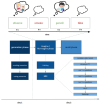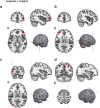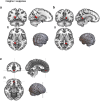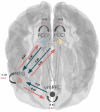Neural correlates of suppressing and imagining future threat
- PMID: 40113972
- PMCID: PMC11926172
- DOI: 10.1038/s41598-025-94580-3
Neural correlates of suppressing and imagining future threat
Abstract
Suppressing upsetting thoughts can cause psychological distress but might also enhance mental health when used flexibly to suppress the imagination of future threat during challenging times. To investigate the neural correlates of suppressing and imagining future threat, a cohort of 65 participants underwent a previously examined "Imagine/No-Imagine" paradigm while examining brain activation using magnetic resonance imaging. We observed activity of the inferior frontal gyrus, middle frontal gyrus (MFG), superior parietal lobule, and superior occipital sulcus during thought suppression, whereas imagining future threat elicited activation in the bilateral posterior cingulate cortex (PCC) and ventromedial prefrontal cortex (vmPFC). Subjective levels of anxiety, stress, and depression as covariates did not alter these results. To further examine the group and individual-level network dynamics, we conducted dynamic causal modeling (DCM) and group iterative multiple model estimations (GIMME). The DCM model showed that during suppression, the MFG positively influenced the vmPFC and right PCC. In contrast, the vmPFC and the left and right PCC showed positive connections to the MFG during imagining. This suggests that the neural correlates of self-regulation involve an information flow between the PCC and the PFC. In addition, GIMME identified group-level connections between the right and left PCC and between the left PCC and vmPFC, reflecting the information flow during suppression and imagination of future threat, respectively. Considerable interindividual heterogeneity in the connectivity patterns became apparent, pointing to the existence of different biotypes.
Keywords: Brain network connectivity; DCM; GIMME; Network analysis; Neural correlates; Thought suppression.
© 2025. The Author(s).
Conflict of interest statement
Declaration. Competing interests: The authors declare no competing interests.
Figures





Similar articles
-
Individual differences in functional connectivity during suppression of imagined threat.Cereb Cortex. 2025 Jan 8;35(1):65-76. doi: 10.1093/cercor/bhae458. Cereb Cortex. 2025. PMID: 39578982
-
Neural dynamics of social anxiety during and after anxiety-provoking and relaxation-inducing: A task and resting-state fMRI study.J Affect Disord. 2025 Jul 1;380:655-665. doi: 10.1016/j.jad.2025.03.104. Epub 2025 Mar 21. J Affect Disord. 2025. PMID: 40122256
-
Brain activation and subjective anxiety during an anticipatory anxiety task is related to clinical outcome during prazosin treatment for alcohol use disorder.Neuroimage Clin. 2020;26:102162. doi: 10.1016/j.nicl.2020.102162. Epub 2020 Jan 10. Neuroimage Clin. 2020. PMID: 32037283 Free PMC article. Clinical Trial.
-
The neural basis of pain during labor.Am J Obstet Gynecol. 2023 May;228(5S):S1241-S1245. doi: 10.1016/j.ajog.2023.02.012. Epub 2023 Mar 21. Am J Obstet Gynecol. 2023. PMID: 36948996 Review.
-
The structural and functional connectivity of the posterior cingulate cortex: comparison between deterministic and probabilistic tractography for the investigation of structure-function relationships.Neuroimage. 2014 Nov 15;102 Pt 1:118-27. doi: 10.1016/j.neuroimage.2013.12.022. Epub 2013 Dec 21. Neuroimage. 2014. PMID: 24365673 Review.
References
-
- Killingsworth, M. A. & Gilbert, D. T. A wandering mind is an unhappy mind. Science330, 932–932 (2010). - PubMed
-
- Miloyan, B., Pachana, N. A. & Suddendorf, T. The future is here: A review of foresight systems in anxiety and depression. Cogn. Emot.28, 795–810 (2014). - PubMed
-
- MacLeod, A. K. & Byrne, A. Anxiety, depression, and the anticipation of future positive and negative experiences. J. Abnormal Psychol.105, 286–289 (1996). - PubMed
MeSH terms
LinkOut - more resources
Full Text Sources
Miscellaneous

